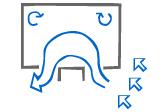
While not strictly vents in their own right, strategically placed wing walls or similar mechanisms can make a big difference to the way that air is directed into a house.
Every object on your block of land (and your neighbours’ blocks) affects the way the wind moves. Every tree, bush, shrub or fence can change the direction of the wind in either a positive or negative way.

How do wing walls work?
If you have a hedge on the windward side of your home, it can divert the wind away from your home. Similarly, a wing wall is a solid panel alongside windows that can be used to redirect or guide air into a home. A particularly good example of how a wing wall works would be casement windows. The effectiveness of windows in terms of ventilation relies on which windows are opened and how far they are opened. Windows with large opening areas and doors that open fully will increase the passage of breezes. Casement windows pivot outwards on hinges like a door, creating a wing-wall type effect. The advantage of this style of window is the ability to maximise and control breezes, and direct them into any area of your home.
How effective are wing walls?
Wing walls are designed to allow the most amount of natural air into your home as possible. Pairing two wing walls, one larger and one smaller, allows you to improve airflow using a cross ventilation system.
|
Advantages
|
Disadvantages
|





